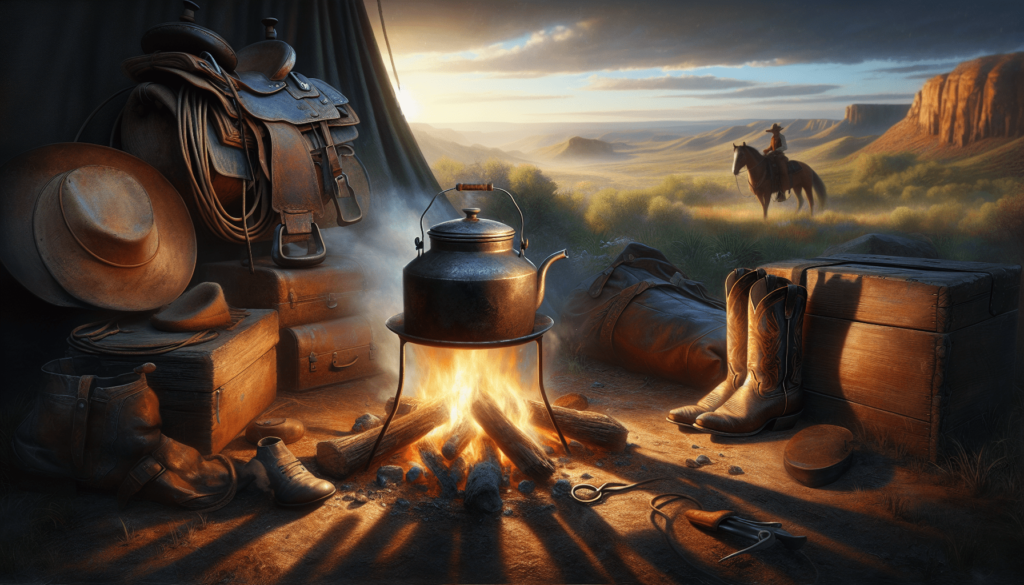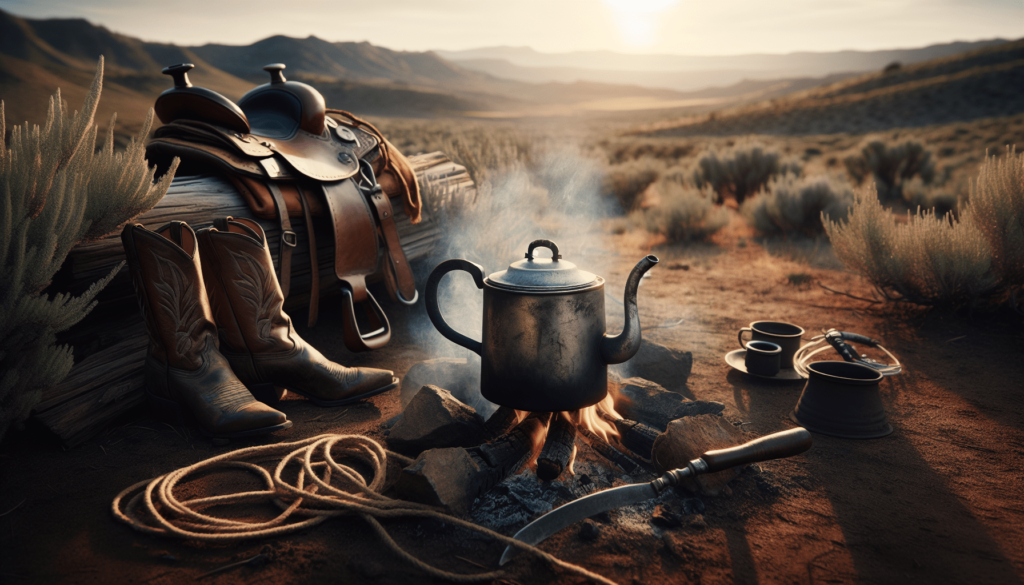Have you ever wondered how cowboys made their coffee out on the open range? The stories and legends of the Old West often feature these rugged individuals who relied on simple but effective methods to brew their morning coffee. This unique way of making coffee became known as “cowboy coffee,” and it’s a fascinating part of American history.

What is Cowboy Coffee?
Cowboy coffee is a traditional method of coffee preparation that was used by cowboys, ranchers, and pioneers during the era of the American Old West. It’s known for its simplicity and the robust flavor that results from its unique brewing method. Unlike modern coffee-making techniques that use sophisticated machines, cowboy coffee requires just a few basic ingredients and tools.
The Core Ingredients
The primary components of cowboy coffee are straightforward:
- Coffee grounds: Coarsely ground beans are preferred.
- Water: Typically drawn from a nearby stream or carried in canteens.
- Heat source: An open campfire or a makeshift stove.
Basic Equipment
The tools involved are just as simple:
- Coffee pot or kettle: Often made of tin or enamel.
- Stirring spoon: A simple wooden or metal spoon for stirring.
- Cup: Usually a tin or enamel mug.
The Historical Context
The Origins in the Old West
Cowboy coffee emerged out of necessity during cattle drives and long trips across the plains. Cowboys couldn’t lug around heavy equipment or complex brewing devices. They needed something portable and easy to use in remote locations.
Importance of Coffee in Cowboy Culture
Coffee wasn’t just a beverage; it was a vital part of a cowboy’s daily life. It provided warmth, comfort, and a much-needed caffeine boost to keep them alert during long, grueling days. Morning and evening coffee breaks became a tradition and a moment of camaraderie among the cowboys.
The Brewing Process
Preparing the Water
First, the water was typically sourced from a river or stream. It was brought to a boil in a pot over an open fire. Boiling the water served two purposes: it killed any potential bacteria and ensured the coffee would extract properly from the grounds.
- Source: River or stream.
- Quantity: Enough to fill the pot and leave room for the coffee grounds.
- Boiling Time: Until a rolling boil was achieved.
Adding Coffee Grounds
Once the water reached a rolling boil, it was time to add the coffee grounds. There was no precise measurement, but a general rule of thumb was two tablespoons of coffee per cup of water.
| Measurement | Quantity |
|---|---|
| Coffee | 2 tablespoons per cup |
| Water | 1 cup per serving |
Stirring and Steeping
The grounds were stirred into the boiling water and left to steep. The pot was removed from the direct heat, but left close enough that the water remained hot. Stirring the coffee a couple of times ensured that the grounds were evenly distributed.
| Action | Duration |
|---|---|
| Stirring | Until mixed well |
| Steeping | 4 to 5 minutes |
Settling the Grounds
One of the key aspects of cowboy coffee is how the grounds are settled. Once the coffee had steeped sufficiently, the pot was given a gentle tap to help settle the grounds to the bottom. Some cowboys also used a trick: they would pour a bit of cold water into the pot to help the grounds sink faster.
Cowboys’ Coffee vs. Modern Coffee
Flavor and Strength
Cowboy coffee is known for its bold and robust flavor. Unlike modern drip coffee makers or espresso machines, cowboy coffee lacks the precision and fine-tuning but makes up for it with its strong, straightforward taste.
Brewing Time
Modern coffee methods emphasize control and consistency, often through sophisticated machines. A drip coffee maker, for example, carefully measures both the water temperature and brewing time. In contrast, cowboy coffee is less precise but quicker to prepare.
Convenience
In the Old West, convenience was key. Cowboys needed a method that didn’t rely on electricity or complex machines. Today, despite still valuing convenience, we tend to lean towards appliances that automate many of the brewing steps.

Variations and Adaptations
Modern Cowboy Coffee
Many camping enthusiasts and outdoor adventurers have adapted cowboy coffee techniques to suit contemporary lifestyles. Portable camping stoves replace open fires, and stainless-steel kettles replace tin or enamel pots.
Using Eggs?
Some variations of cowboy coffee involve adding a raw egg or eggshells to the grounds. The egg helps bind the grounds together, making it easier to settle them at the bottom of the pot. This method results in a cleaner cup of coffee with fewer floating grounds.
Gourmet Twist
Believe it or not, some gourmet coffee enthusiasts have begun to experiment with cowboy coffee methods, using high-quality beans and fine-tuning the process to create a fusion of old and new techniques.
Tips and Tricks for the Perfect Cowboy Coffee
Choose the Right Coffee Grounds
Opt for coarsely ground coffee. Finely ground coffee is more likely to result in a muddy, gritty texture, while coarse grounds are easier to settle and strain.
Utilize Fresh Water
Fresh, clean water results in a better tasting coffee. If you’re out in the wilderness, consider using a portable water filter before boiling your water.
Master the Settling Tricks
Use the cold water trick or allow enough time for the grounds to naturally settle at the bottom. Both methods help ensure a cleaner cup in the end.
Practice Makes Perfect
Like any skill, making the perfect cup of cowboy coffee takes practice. Experiment with different coffee-to-water ratios and steeping times to find your preferred strength and flavor.
Health Benefits and Nutritional Aspects
Rich in Antioxidants
Like all coffee, cowboy coffee is rich in antioxidants, which can help fight free radicals in your body. These antioxidants are believed to reduce inflammation and potentially lower the risk of some chronic diseases.
Caffeine Content
Cowboy coffee contains approximately the same amount of caffeine as other brewing methods. Caffeine provides numerous benefits, including improved mental alertness and potential enhanced physical performance.
Minimal Additives
Since cowboy coffee relies on just water and coffee grounds, it’s free from the additives and artificial flavors often found in commercially-produced coffee products. For fans of pure, unadulterated coffee, this is a significant advantage.
Potential Drawbacks
Acidity
Like many strong brews, cowboy coffee can be quite acidic. For those with sensitive stomachs or acid reflux, this brewing method might not be the best choice.
Grit and Sediment
Despite various methods to settle the grounds, you may still find some sediment at the bottom of your cup. This is a natural by-product of the brewing method and might be off-putting to some.
Inconsistent Results
Since cowboy coffee lacks the precision of modern brewing techniques, the taste and strength of each batch can vary. If you prefer consistency in your morning brew, this may be a downside.
Cultural Significance
Representation in Media
Cowboy coffee has been romanticized in Western films and literature, often symbolizing the ruggedness and resourcefulness of the American cowboy. Whether around a campfire or at a chuck wagon, it features prominently in many iconic scenes.
Modern Day Revival
In recent years, there has been a revival of interest in traditional and manual coffee brewing methods. Cowboy coffee fits perfectly into this trend, offering a nostalgic and adventurous alternative to modern coffee.
Social Experience
For cowboys, making and sharing coffee wasn’t just a necessity but also a social experience. The ritual of brewing and drinking coffee together provided a sense of community and camaraderie, strengthening bonds among fellow riders.
Final Thoughts
Cowboy coffee is more than just a way to make a cup of coffee; it’s a rich tradition that offers a glimpse into the daily life and culture of the American cowboy. Its simplicity, bold flavor, and historical significance make it a fascinating topic for coffee lovers and history enthusiasts alike. Whether you’re an outdoor adventurer looking to try something new or simply curious about old-world coffee brewing methods, cowboy coffee offers a unique and enriching experience.
From its humble beginnings on the open range to its influence on modern-day coffee culture, cowboy coffee remains a testament to the ingenuity and resilience of the cowboys who relied on this simple yet effective brewing method. So, the next time you’re out camping or just craving a strong, straightforward cup of coffee, why not try brewing a pot of cowboy coffee and connect with a piece of the Wild West?
